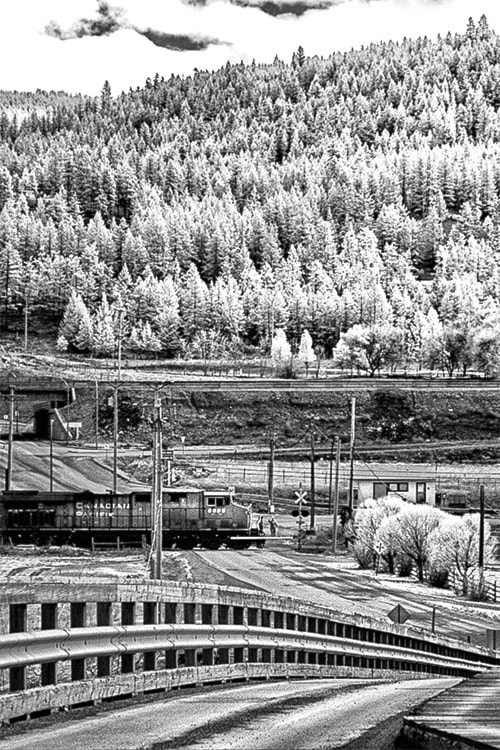The past few weeks have been apparent with flat and overcast skies. That’s certainly not inviting for anyone chomping at the bit to get out with a camera around Kamloops.
Only a short month ago the landscape was covered with glistening white snow that even on overcast days created some interest.
However, that snow has melted this month leaving colourless meadows and a washed-out-looking, green forest of trees. In my opinion, the best word to describe the landscape, even with today’s sparkling sunny day, is grey.
I suppose many landscape photographers get creative and spend some time behind a computer manipulating that grey landscape.
There are a myriad of programs designed to manipulate image files allowing black and white conversion or gritty oversaturation. But those conversions, although creative, in my opinion, don’t really give much life to the landscape.
However, for me it’s simple. I just grabbed my infrared camera and drove down to the large Thompson River that cuts through the valley on its way to Kamloops.
For years I have enjoyed capturing landscapes (and city scapes) using first, infrared film, and then for the past 10 years, a camera converted to only “see” infrared light.
Infrared light is invisible to the human eye. To capture it with a modern DSLR, the camera is converted by blocking all but the infrared light from hitting the sensor.
I enjoy how infrared photography gives me a scene illuminated by that part of the colour spectrum we can’t see, with delightful images that couldn’t be captured in any other way.
Dark skies and glowing white trees are some of my favourite infrared effects.
It is those fresh and exciting photographs (done with very little computer work) that separated my photography from both the monotone conversions, and the oversaturated scenic, that had been viewed on posts by other local photographers.
I like to wander along the winter beach not far from my rural home. Normally the turn-off and sparsely tree-lined beach is well used by locals with motorbikes and bicycles, walking their dogs, or launching their fishing boats.
However, the winter beach on the river is empty, especially on cold days, and it’s those days that I enjoy the most.
I can stroll along the narrow walkway that goes over the bridge while taking pictures of the river valley. And although there is a sign that tells walkers not to loiter or fish from the bridge, in all the years that I have been making pictures from it, no one has ever bothered me.
Most of the time people smile and wave from their vehicles as they pass me.
I roam under the bridge and search the sandy riverside photographing interesting features and trash left over from winters’ storms, and, in spite of everything being shades of grey, infrared changes everything, and I have the choice in post-production to choose surreal coloured, or unique black and white images.
I’ll repeat what I wrote when discussing infrared in my article last November, “Infrared allows a photographer, and gives the viewer, a completely different feeling of a subject. Making an image with a modified camera is an exploration and a discovery that moves a photographer far from the usual”.
These are my thoughts for this week. Contact me at emcam@telus.net. Stop by Enman’s Camera at 423 Tranquille Road in Kamloops. I sell an interesting selection of used photographic equipment. Call me at 250-371-3069.
